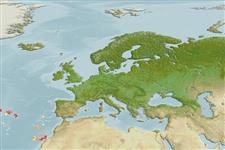Teleostei (teleosts) >
Gadiformes (Cods) >
Gaidropsaridae (Rocklings)
Etymology: Gaidropsarus: Greek, ga, ge = the earth + Greek, ydro = water + Greek psaros = speckled, starling (Ref. 45335).
Eponymy: William Robert Ogilvie-Grant (1863–1924) was a Scottish ornithologist. [...] (Ref. 128868), visit book page.
More on author: Regan.
Environment: milieu / climate zone / depth range / distribution range
Ecology
Marine; demersal; depth range 20 - 250 m (Ref. 83500). Tropical; 40°N - 27°N, 32°W - 13°W
Eastern Atlantic: Canary Islands and the Azores. A few specimens of this species have been caught recently from the central and eastern Mediterranean (Ref. 83500).
Size / Weight / Age
Maturity: Lm ? range ? - ? cm
Max length : 36.0 cm SL male/unsexed; (Ref. 6144)
Not commonly caught. Feeds on palaemonid prawns. Rare species.
Life cycle and mating behavior
Maturity | Reproduction | Spawning | Eggs | Fecundity | Larvae
Cohen, D.M., 1990. Gadidae. p. 526-531. In J.C. Quero, J.C. Hureau, C. Karrer, A. Post and L. Saldanha (eds.) Check-list of the fishes of the eastern tropical Atlantic (CLOFETA). JNICT, Lisbon; SEI, Paris; and UNESCO, Paris. Vol. 2. (Ref. 6144)
IUCN Red List Status (Ref. 130435: Version 2024-1)
Threat to humans
Harmless
Human uses
Fisheries: commercial
Tools
Special reports
Download XML
Internet sources
Estimates based on models
Preferred temperature (Ref.
123201): 9.9 - 10, mean 10 °C (based on 2 cells).
Phylogenetic diversity index (Ref.
82804): PD
50 = 0.5001 [Uniqueness, from 0.5 = low to 2.0 = high].
Bayesian length-weight: a=0.00468 (0.00205 - 0.01068), b=3.08 (2.89 - 3.27), in cm total length, based on LWR estimates for this (Sub)family-body shape (Ref.
93245).
Trophic level (Ref.
69278): 3.6 ±0.59 se; based on food items.
Resilience (Ref.
120179): Medium, minimum population doubling time 1.4 - 4.4 years (Preliminary K or Fecundity.).
Fishing Vulnerability (Ref.
59153): Low to moderate vulnerability (34 of 100).
